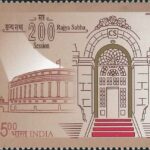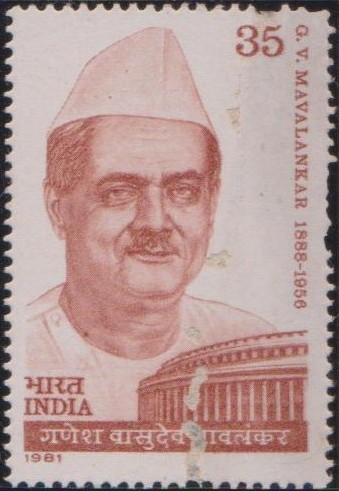
Lok Sabha Secretariat
A commemorative postage stamp on the Diamond Jubilee of Parliament of India, Lok Sabha :
 Issued by India
Issued by India
Issued on Jan 10, 1989
Issued for : The stamp is being issued to commemorate the Diamond Jubilee of the Lok Sabha Secretariat, which continues to maintain a tradition of impartiality, objectivity, dedication and promptitude handed down to it over the decades as also a distinct work culture of its own to meet the special requirements of the Parliament and its Members.
Description of Design : The stamp is designed by India Security Press, Nashik Road, the first day cover by Samaresh Chatterjee and the cancellation by Alka Sharma. The Lok Sabha Secretariat is depicted on the stamp and Parliament House, New Delhi on the first day cover.
Type : Stamp, Mint Condition
Colour : Single Colour
Denomination : 60 Paise
Overall size : 3.91 x 2.90 cms.
Printing size : 3.55 x 2.54 cms.
Perforation : 13 x 13
Paper : Imported un W/M Adh. Gr. Coated stamp paper
Number Printed : 15,00,000
Number per issue sheet : 35
Printing Process : Photogravure
Printed : India Security Press
About :
- The foundation of a separate Central Legislature Secretariat, independent of the control of the Government, was laid in India on 10 January, 1929. The historic development was the culmination of the relentless efforts Shri Vithalbhai Patel, the first elected Indian Speaker (then called President) of the then Central Legislative Assembly, who zealously guarded, asserted and upheld the independence of the office of Speaker even in those difficult times.
- The concept of a separate Secretariat for the Indian Legislature, independent of the control of the Government, was conceived first in 1926 when the Conference of Presiding Officers of Legislative Bodies in India, presided over by Shri Vithalbhai Patel, adopted a Resolution proposing the creation of a separate Secretariat for the Central Legislative Assembly. This was followed, two years later, on 22 September 1928, by a Resolution moved in the Central Legislative Assembly by Pandit Motilal Nehru and seconded, among others, by Lala Lajpat Rai, seeking the constitution of a separate Assembly Department. The principal terms of the Resolution were:
(i) A separate Assembly Department should be constituted not later than 1 December, 1928;(ii) The Assembly Department should be included in the portfolio of the Governor-General and the principal officers of the Department should be appointed by him in consultation with the Presiding Officer;
(iii) The other members of the establishment should be appointed by the Presiding Officer in consultation with the Secretary; and
(iv) The question of expenditure should be dealt with in the ordinary manner, but in case of difference of opinion between the Presiding Officer and the Government of India, there should be a reference to the Governor-General, whose decision was to be final.
- This Resolution, adopted unanimously, in fact became “the source of creation and authority of the Assembly Department.” As a result, a separate Department known as the “Legislative Assembly Department“ came into being on 10 January 1929, in the portfolio of the Governor-General with the Speaker of the Legislative Assembly as its defacto head.
- With the coming into force of the Constitution of India on 26 January 1950, the name of the Department was changed to “Parliament Secretariat“. In 1954, the name of the Secretariat was changed from “Parliament Secretariat” to “Lok Sabha Secretariat.”








[…] designed by Pulak Biswas as has been the First Day Cover, on the basis of material furnished by the Lok Sabha Secretariat. The cancellation has been designed by Neenu […]
[…] contributions. He was nominated as a member of the Constituent Assembly, and got elected to the Lok Sabha from Kanpur Constituency in the first General Elections. From 1957, he continued to be a member of […]
[…] Aney was elected to the Parliament from Nagpur in the year 1959. He was a Member of the Lok sabha from 1959 to […]
[…] for Scheduled Tribes and one for Scheduled Castes. The people of Manipur elect two MPs for the Lok Sabha and one MP for the Rajya […]
[…] also. He was elected to the then Bombay Legislative Assembly in 1952. He was also elected to the Lok Sabha in 1962. As President of Shri Siddheshwar Deosthan Panch Committee, Solapur, he […]
[…] Lok Dal with the Janata Party of which he was also one of the founder members. Elected to the Lok Sabha in 1977, he was the Home Minister in the Janata Government. In 1979 he became Deputy Prime Minister […]
[…] of India. The Congress (I) Party won an overwhelming victory and Sanjay Gandhi was elected to the Lok Sabha in January 1980 from […]
[…] of the Legislative assembly of U.P. He was also elected to the Constituent Assembly in 1946, to the Lok Sabha in 1952 and to the Rajya Sabha in 1956. He retired from active public life after 1956 due to […]
[…] adjacent to the present building, the new building has larger Lok Sabha and Rajya Sabha halls. Modern technology and building systems for the efficient functioning of an […]
[…] offices of President of India, Vice-President, the Upper House (Rajya Sabha) and the Lower House (Lok Sabha) of Parliament and to both Upper and Lower Houses of the State […]